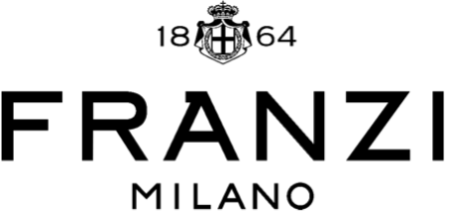
Franzi
Leather goods factory. In 1864, Felice Franzi established a leather goods factory in Milan and named it after himself. It was the first in Europe to produce a well-known, very strong leather tanned with vegetable products. By using his superior part, which is impressed the Franzi grain upon, they are produced trunks, suitcases and very elegant bags, in addiction to a wide variety of small leather goods.
The Origins
Franzi’s story begins in 1840, when Rocco Franzi moves his workshop from Viggiù (VA) to Milan, opening a small shop specialized in the production of fine trunks and suitcases. Among his most successful creations there is the ‘Leggerissimo’ trunk, designed to reduce the total weight of travellers’ luggage and the transport costs. The national and international prizes and awards he obtained determined the brand’s initial success.

Felice Franzi: the brand foundation
In 1864 Felice Franzi, Rocco’s son, officially founds the “Valigeria Franzi” in Via Manzoni, in Milan. In order to improve and update the manufacturing processes, he hires French and Austrian artisans and he introduces modern tanning techniques from Germany, thus creating the first Italian fine leather district. Among his apprentices, Guccio Gucci emerges. He himself, in order to promote his shop, wrote in his poster “Guccio Gucci, already employed at Valigeria Franzi”. In 1877, Felice manages to serve the Italian Real Houses: therefore, a few years later, the Savoia chose him as official server of the Family.
The brand expansion
At the beginning of XX century, Franzi’s catalogue consisted of trunks, suitcases, bags and beauty-cases with custom-made glass, silver and enamel recipients. It also included women bags, small leather goods, dog collars, knives, wallets, watches, razors and others leather and precious metal travel-dedicated accessories.
Furthermore, through time, Franzi took part in several national and international expositions, and in 1905, after the Milan shop’s success, he expanded his network in Rome, Genova, Naples, London and Wien, becoming the first luxury leather shop with an international commercial network. After that, the brand managed to become official server for the Austrian Emperor, the King of Greece and the King of Egypt.
Oreste Franzi: his voyages in Asia
At the beginning of XX century Oreste Franzi, Felice’s son, travelled several times to Asia, in order to study innovative leather treatments and tanning techniques. The knowledge he obtained was optimized at Conceria Monzese, among the first European industrial factories which produced skins treated with vegetal agents: the so-called vegetal tanning, which makes the leather softer, increases its resistance and allows to obtain brighter and more long-lasting colors. That’s the birth of the renowned Cuoio Franzi, became famous worldwide in the luxury leather production and characterized by an organic weft, which makes it really adaptable and strong.
The Cuoio Franzi
The Cuoio Franzi, also called “Franzino”, is a particular skin characterized by a printed organic weft. His structure is obtained through the treatment of leather, which is firstly rolled diagonally and then perpendicularly when it is still saturated with the tanning vegetal agents.
After his birth, the Cuoio Franzi obtained an immediate success in several branches. Today it’s still renowned for its softness, versatility and resistance, beyond his long-lasting and bright colors. Other than that, it’s used for many cars’ interiors, such as Maserati and Ferrari, and for luxury trains and old ocean liners, such as the Raffaello and the Michelangelo.
Collaborations with architects and designers
During the ’60s, Franzi increasingly collaborates with design and furniture industries. He also worked with the Italian designer Cini Boeri, creating a new overnight bags’ line, named ABS Partner: some of this collection items are today part of the permanent collection at MoMA in New York and at Triennale in Milan.
The economic slowdown in ’80s and ’90s and the brand rebirth
During the ’80s and ’90s, Franzi’s commercial activity downgraded, and in 1998 the last factory closed. But in 2016, the Italian Manager Marco Calzoni and the German Television Producer Stefan Oelze acquired the company and its archives; in 2021 they renewed the brand with the Margherita bag, dedicated to the first Italian Queen.

